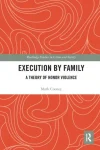Execution by Family: A Theory of Honor Violence
 Author: Mark Cooney
Author: Mark Cooney
Publisher: Routledge, 2020. 236 pages.
Reviewer: Bradley Campbell | March 2023
In Execution by Family: A Theory of Honor Violence, author Mark Cooney has succeeded in what he was trying to do — to develop a general, parsimonious, novel, testable, and valid explanation of family honor violence (pp. 195-196). Some readers, no doubt, will think that is not enough. And it is true that the book does not say everything there is to say about this form of violence. As Cooney says, “My theory … is different from many theories that focus directly on honor violence. Many such theories are political in that they condemn honor violence as a particularly pure form of misogynistic domination. The theory presented here, by contrast, is scientific” (p. 194). Those whose primary concern about family honor violence has to do with the morality or the politics of it might bristle at the book’s neglect of these issues. I would argue, though, that this is part of what enables Cooney to explain family honor violence so effectively. We can see this both with Cooney’s concept of family honor violence as well as with his explanation. In both cases, he was able to do better than other scholars, in part, by putting moral concerns to the side.
The Concept of Family Honor Violence
Family honor violence, as Cooney defines it, is violence by a family against a family member who has undermined the family’s moral status. In its pure form, family honor violence is collaborative, preplanned, justified using the language of honor, and approved of by the surrounding community. It occurs mainly in countries that are part of what can be called the honor belt, which ranges “from north Africa, through the Middle East and Turkey, across to southeast Asia” (p. 77). Many of the cultures in this region can be thought of as cultures of honor, though not all cultures of honor have family honor violence. We usually associate honor with duels, blood feuds, or other killings between men in retaliation for an insult or an act of violence. Honor in that sense has to do mainly with a man’s reputation for bravery, and in order to maintain his honor, he has to defend himself and his reputation. But in many of these societies, honor is also associated with a woman’s reputation for sexual purity — virginity if she’s unmarried and faithfulness to her husband if she’s married. A woman who engages in premarital sex or adultery, or even a woman who’s been raped, brings shame on her family. Or she might also bring shame through disobedience or anything else that deviates from what is considered her “proper role.” Family honor violence, then, is frequently against a young woman by her father or her brothers, and the woman is commonly accused of adultery or some other form of sexual immorality.
As a form of violence directed against women and other low status members of families, family honor violence is a social justice and human rights concern not only for westerners but also for activists within the countries where it is most frequent (p. 198). But many activists are also careful about how they talk about the issue due to a worry about stigmatizing non-Western cultures (p. 198).
These are understandable moral concerns, but if we are going to better understand violence, our first task is to describe it as clearly as possible. Many scholars have instead let their social justice concerns distort their understanding of family honor violence. It is common, for example, to deny that family honor violence is a distinct form of violence at all, to say that it is just domestic violence. As Cooney points out, this is primarily a political argument (p. 36). What is important about the violence, from this standpoint, is that it is a way of controlling women, and anything that distinguishes it from spousal abuse and the domestic violence occurring in the West is not important. Highlighting that is just a way of portraying non-Western cultures as primitive or violent, the idea goes.
A concept cannot be right or wrong, but in can be useful or less useful, and what we want from a concept first of all is usefulness in describing the world. We want a concept that helps us clarify things. Lumping family honor violence in with domestic violence does not do this. As Cooney shows, several things distinguish this violence from what we call domestic violence. It is carried out on behalf of a family, for example, and in a context where the family has lost status in the community because of the person targeted. Cooney’s concept helps us describe and classify these acts of violence.
The Theory of Family Honor Violence
Explanations of family honor violence have also been distorted by social justice concerns, just as the concept has. For example, Cooney shows that an explanation of family honor violence that he calls “patriarchy theory” cannot explain very much about the violence. And part of the problem with patriarchy theory is that it “tends to be self-consciously political” (p. 56). Family honor killings are usually directed against women or girls, and patriarchy theorists see these killings as a product of male dominance. They see them as one of many forms of violence against women that arise from and reinforce the dominance of men over women, and their goal is often to call attention to these killings in the hope of eliminating them.
These theorists are right that honor killings occur in patriarchal families and communities, so this is an important part of explaining them, but the problem is that highly patriarchal societies are much more common than family honor violence. And while most of the targets are women or girls, not all of them are, and patriarchy cannot explain the killing of, say, a disobedient son. Any powerful explanation is going to need to bring in other variables, but patriarchy theorists sometimes resist this for moral reasons. They resist cultural explanations of family honor killings, for example, because they believe, as Cooney puts it, that “to attribute honor violence to a culture’s values is to imply the backwardness of the people who carry that culture and the superiority of Westerners who do not” (p. 56).
Patriarchy theory is a general, simple, and somewhat testable explanation, but it is not high in validity. It is at best a weak explanation of why some societies have family honor violence and others do not, but it does not explain why offenses by men sometimes result in honor killings, and it does not explain at all why even in societies where there is family honor violence, the same offense might lead to an honor killing on one occasion but not another. Cooney’s theory does explain these things, and it does this by bringing in other variables. Family honor killings occur under conditions of male dominance, to be sure, but other kinds of inequality are also important, such as the dominance of the community over the family, the family over the individual, and the old over the young. This helps us understand why the targets are most often young women perceived as disobedient in some way to their fathers or other family authorities, and it also helps us understand why other family members might also be targeted.
Cooney’s explanation works better than others because it points to the role of multiple types of inequality, not just gender inequality, but also because it points to the importance of social distance. One aspect of social distance is a lack of intimacy, so that strangers, for instance, are more distant from one another than friends and family members. Another aspect of social distance has to do with differences in culture, so that people who have different religions or speak different languages are more distant from one another than those who share the same religion or language. Just as inequality within a family makes family honor violence more likely, social distance within a family also makes family honor violence more likely. This means that a family member who lives with another family or who dresses differently is also more likely to be targeted.
While there is a great deal of inequality within many families, all families are close to some degree. This helps us understand a peculiar feature of family honor violence that non-specialists in the subject probably are not even aware of. That is, even where honor killings occur, families are often reluctant to kill a family member who has engaged in the kind of behavior that brings dishonor to the family. Their first response might be to ignore the offense, and it might be a long time before they kill. Social closeness within the family leads to compassion for the offender, but the dominance of the family over the individual and the community over the family leads to concern for the family’s social standing.
The Value of the Theory
Cooney highlights and explains many other features of family honor violence as well, and it is clear that the theory is powerful. It is general in that it applies across cultural settings and time periods, and it draws from and is consistent with other theories of conflict and violence. It is a parsimonious explanation, explaining a great deal with just a few variables. It is new, drawing from previous theories but unlike any of them. It states clearly the expected relationships between observable variables, so it is readily testable, and given all the facts about family honor killings that it explains, it appears to be highly valid as well.
That does not mean it is perfect. For example, I do not think it fully explains the violence against rape victims. I understand why the rape of a woman brings dishonor in the same way that other premarital sexual encounters do, if the focus is on the woman’s virginity. But it is harder to understand why it would lead to the punishment of the victim, rather than the rapist. In other contexts the rapist is punished, and the theory does not explain this variation. Related to that, even in cases of premarital sex or adultery, why is the man targeted in some cases but not others?
Jason Manning pointed to a similar problem in a recent article in the Journal of Qualitative Criminal Justice and Criminology titled “Infidelity, Liability, and Violence.” This is about another form of violence — homicides arising from infidelity and sexual jealousy. In these cases the jealous partner, usually a man, is reacting to the offense. But there is variation in whether he kills his romantic partner, his romantic rival, or both. Manning offers some speculation about what might explain the patterns, but he says this is something that needs more work. Manning draws from Donald Black’s theory of conflict, as Cooney does, and I wonder if a shortcoming of this broader theory is that it often predicts the occurrence of conflict better than it predicts who will be held responsible for it.
In any case, while Cooney’s theory does not explain everything, it does make an impressive contribution to our understanding of family honor violence. In ignoring the moral concerns that have constrained previous concepts and theories, Cooney has been able to better describe and explain this phenomenon than previous scholars. But has he done something wrong? By explaining family honor violence without regard to the morality of it, has he undermined social justice? Will his theory make the world worse off? We cannot know the answer to this, but I do want to push back on the common assumption that activist scholarship is somehow morally better than scientific scholarship. Is a bad theory that sounds right for ideological reasons really going to be as useful in informing social justice efforts as a good theory will be?
Even if your primary concern is with morality or politics, you should welcome what Cooney has done here. If you want to do something about family honor violence, it should help you to have good information about it and about the conditions in which it occurs. Trying to change the world without understanding it first is bound to result in failure.
Bradley Campbell is a Professor of Sociology at California State University, Los Angeles.


